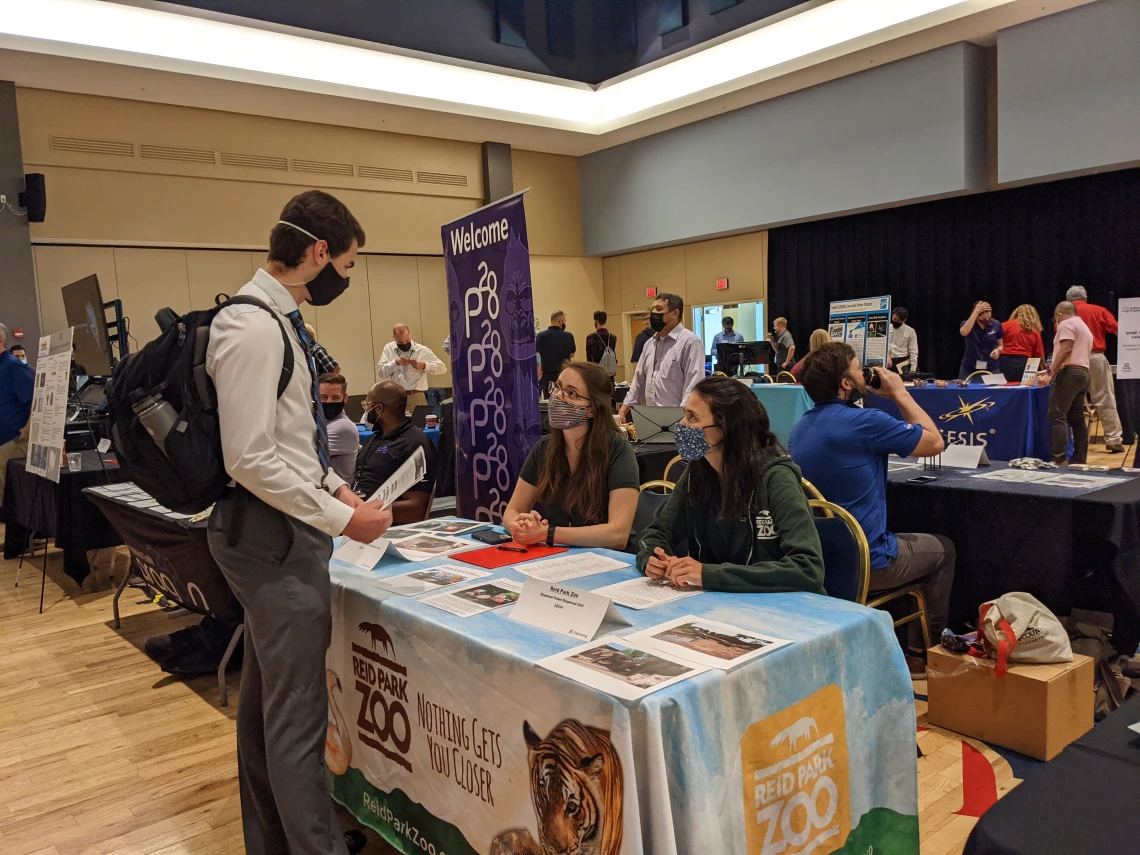Open House 2021 Returns to In-Person Format

Dozens of companies and hundreds of engineering seniors descended upon the Student Memorial Center in late August, each searching for a perfect match for a capstone project. Companies set up tables decked out with candy, branded materials, monitors and robots. Students brought their resumes and A-games, hoping to impress the companies with which they were most interested in working.
But, before the students arrived, program and college leadership welcomed sponsor representatives with a breakfast. David W. Hahn, the college’s Craig M. Berge dean, spoke about how the college adjusted during the pandemic to provide the best possible hands-on, experiential learning.
“You made it happen,” he said. “You kept the engineering mantra of adaptability. We got through the last year – a full academic cycle – of unusual conditions. And Design Day, even though it was virtual, was a fantastic success.”
Steve Larimore and Larry Head also spoke to the group about some of the changes in the program this year, primarily centered around ensuring students meet specific milestones earlier in their senior year. This ties into the larger Craig M. Berge Design Program strategy of engaging students in hands-on learning from their very first year.
“If we’re going to build the ability to be innovative and creative in our students, we have to build skills and those opportunities earlier,” said Larry Head, director of the Craig M. Berge Engineering Design Program.
Tackling Real-World Problems
Northrup Grumman employee Sierra Rose explained that the company is sponsoring a project to design a thermal rocket cover to regulate temperature for avionics, and which can be easily removed without damaging the rocket. Fittingly, she had just returned from a launch campaign in Alaska, where they were running tests on related technology.
“I love working with students,” said Rose, a 2019 mechanical engineering alum. “I didn’t want to pick just any project for the students to do. I wanted to do something applicable and interesting to them. I thought, ‘If I was in their position, would this be something I would want to do?’”
Arete employees Chris Ryerson and Patrick Baker, a 2020 mechanical engineering alum, shared a similar sentiment about the real-world applicability of their airborne imaging system for motion compensation.
“We genuinely need it,” Ryerson said. “It’s not just a made-up project – we actually want to offer this capability to our customers.”
Returning for Round Two
Many companies have been sponsoring capstone projects for years, and they adjusted to last year’s virtual alternatives right along with the college. For some, the 2020-2021 academic year was their first go-round with the program. Andrew Ryan of the Lunar and Planetary Laboratory said he was impressed with the work last year’s team did on a device to test the thermal conductivity of asteroid samples, in preparation for the return of the OSIRIS-REx spacecraft.
“I just presented last week at a conference in Chicago, and I had all of the students listed as coauthors on the conference paper when I was presenting the design,” he said. “It was very well received.”
Truman Louth, who was representing the sports equipment company PING along with Curt Pawley and Tom Trueblood, is a testament to how teams and sponsors came together to make it work. Last year, Louth was a student working on PING’s project to automate the loading and unloading of golf shafts. This year, he’s a full-time employee who will mentor seniors designing a putter pendulum to deliver a putter at a consistent speed.
“It was a really good experience for us and gave us a great opportunity to get to know some of the students at the UA,” Trueblood said. “We see a lot of potential here. We’re local, and we’d love to be able to get more involved in local universities and develop a working relationship.”
The Reid Park Zoo sponsored two successful projects last year, supported with funding from the Craig M. Berge dean’s endowment. One was a motion-activated animal enrichment device that allows animals to turn on features like fans, misters and visual displays. It won the Raytheon Technologies Award for Best Overall Design at Design Day 2021. Stephanie Norton, a Reid Park Zoo animal welfare specialist, said the devices are so popular that they haven’t settled in any one enclosure yet – the animal keepers are so excited about the devices that they’re rotating it around to different enclosures.
This year, they raised funds for two automated dispensing devices. One will specialize in distributing fresh or frozen food (as opposed to pellets), and non-food items such as toys and branches. The other will send pellets into the air to land throughout the elephant habitat for foraging.
“We have so much space, and we can only throw so far,” said Michelle Dicosola, an elephant zookeeper, adding that she has wanted such a device for years. “It’s going to be really cool to be able to utilize more of their yard for them and have them looking around more.”
After Open House, sponsors and students submitted their top choices for who they wanted to work with. This year saw a record rate of student voting, at 98%. Every company is matched with a team of students ready to take on the year.

